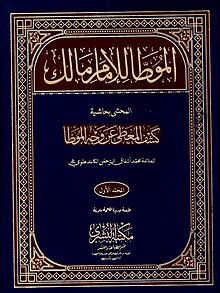 | |
| Author | Imam Malik ibn Anas |
|---|---|
| Original title | موطأ الإمام مالك |
| Language | Arabic |
| Genre | Hadith collection |
| Part of a series on |
| Hadith |
|---|
 |
|
|
The Muwaṭṭaʾ (Arabic: الموطأ, "well-trodden path") or Muwatta Imam Malik (Arabic: موطأ الإمام مالك) of Imam Malik (711–795) written in the 8th-century, is one of the earliest collections of hadith texts comprising the subjects of Islamic law, compiled by the Imam, Malik ibn Anas.[1] Malik's best-known work, Al-Muwatta was the first legal work to incorporate and combine hadith and fiqh (except possibly for Zayd ibn Ali's Musnad).[2]
It is considered to be from the earliest extant collections of hadith that form the basis of Islamic jurisprudence alongside the Qur'an.[3] It includes reliable hadith from the people of the Hijaz, as well as sayings of the companions, the followers and also those who came after them.[4] The book covers rituals, rites, customs, traditions, norms and laws of the time of the Islamic prophet Muhammad.[5]
It is reported that Imam Malik selected for inclusion into the Muwatta just over 1900 narrations,[6] from the 100,000 narrations he had available to him.[7]
Due to increase in juristic differences, the Caliph of the time, Abū Ja‘far al-Manṣūr, requested Imām Mālik to produce a standard book that could be promulgated as law in the country. The Imam refused this in 148 AH (765/766 CE), but when the Caliph again came to the Ḥijāz in 163 AH (779/780 CE), he was more forceful and said:[citation needed]
“O Abū ‘Abd Allāh, take up the reign of the discipline of fiqh in your hands. Compile your understanding of every issue in different chapters for a systematic book free from the harshness of ‘Abd Allāh b. ‘Umar, concessions and accommodations of ‘Abd Allāh b. ‘Abbās and unique views of ‘Abd Allāh b. Mas‘ūd. Your work should exemplify the following principle of the Prophet: “The best issues are those which are balanced.”[citation needed] It should be a compendium of the agreed upon views of the Companions and the elder imāms on the religious and legal issues. Once you have compiled such a work then we would be able to unite the Muslims in following the single fiqh worked by you. We would then promulgate it in the entire Muslim state. We would order that no body acts contrary to it.” [8]
Historical reports attest that another ‘Abbāsī caliph Harun al-Rashid too expressed similar wishes before Imām Mālik who remained unmoved.[citation needed] He, however, compiled Muwaṭṭa’, keeping before himself the target of removing the juristic differences between the scholars.[citation needed]
| Part of a series on Sunni Islam |
|---|
|
|
The work was composed over a forty-year period. According to Abu Hatim al-Razi[specify] it was called 'Muwatta' from the Arabic ("watta'a") meaning easy for the people.[7] Malik said, "I showed this book of mine to seventy of the fuqaha of Madinah and all of them agreed with me ("wata'a") about it and so I called it the Muwatta.[9]
The Muslim Jurist, Muhammad ibn Idris ash-Shafi`i also called Imam Al Shafi`i famously said, "There is not on the face of the earth a book – after the Book of Allah – which is more authentic than the book of Malik."[10]
Over one thousand disciples of Malik have transmitted this work from him throughout his life, which resulted in differences in the text. There are many editions of the work - with sixteen being known today - of which the most famous is the one transmitted by Yahya ibn Yahya al-Laythi,[11] who studied and received the Muwatta in the last year of Malik's life.[12] Al-Laythi's recension is considered the 'vulgate' or standard version in the Maliki school of law.[13]
The recension of the Muwatta produced by Ahmad ibn Abi Bakr al-Zuhri is approximately five to ten percent larger than the recension of al-Laythi.[14]
Al-Muwatta consists of approximately 1,720 hadith divided amongst the following hadith terminology as follows:[3]
Amin Ahsan Islahi has listed several distinguishing characteristics of the Muwatta:[15]
Due to the importance of the Al-Muwatta to Muslims it has often been accompanied by commentaries, mostly but not exclusively by followers of the Maliki school. It's said that on the version transmitted by Yahya al-Laithi alone there are around a hundred commentaries.[16]